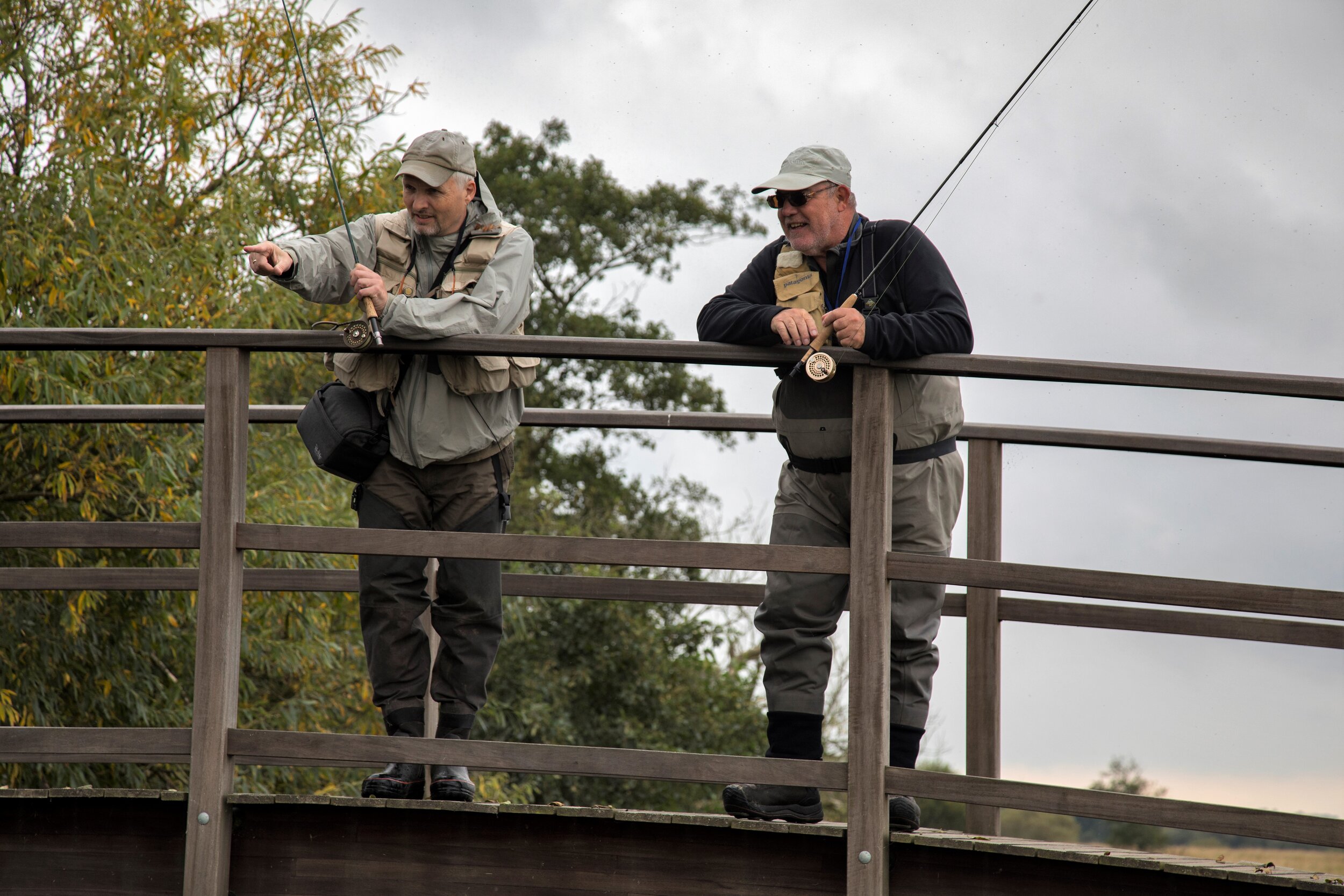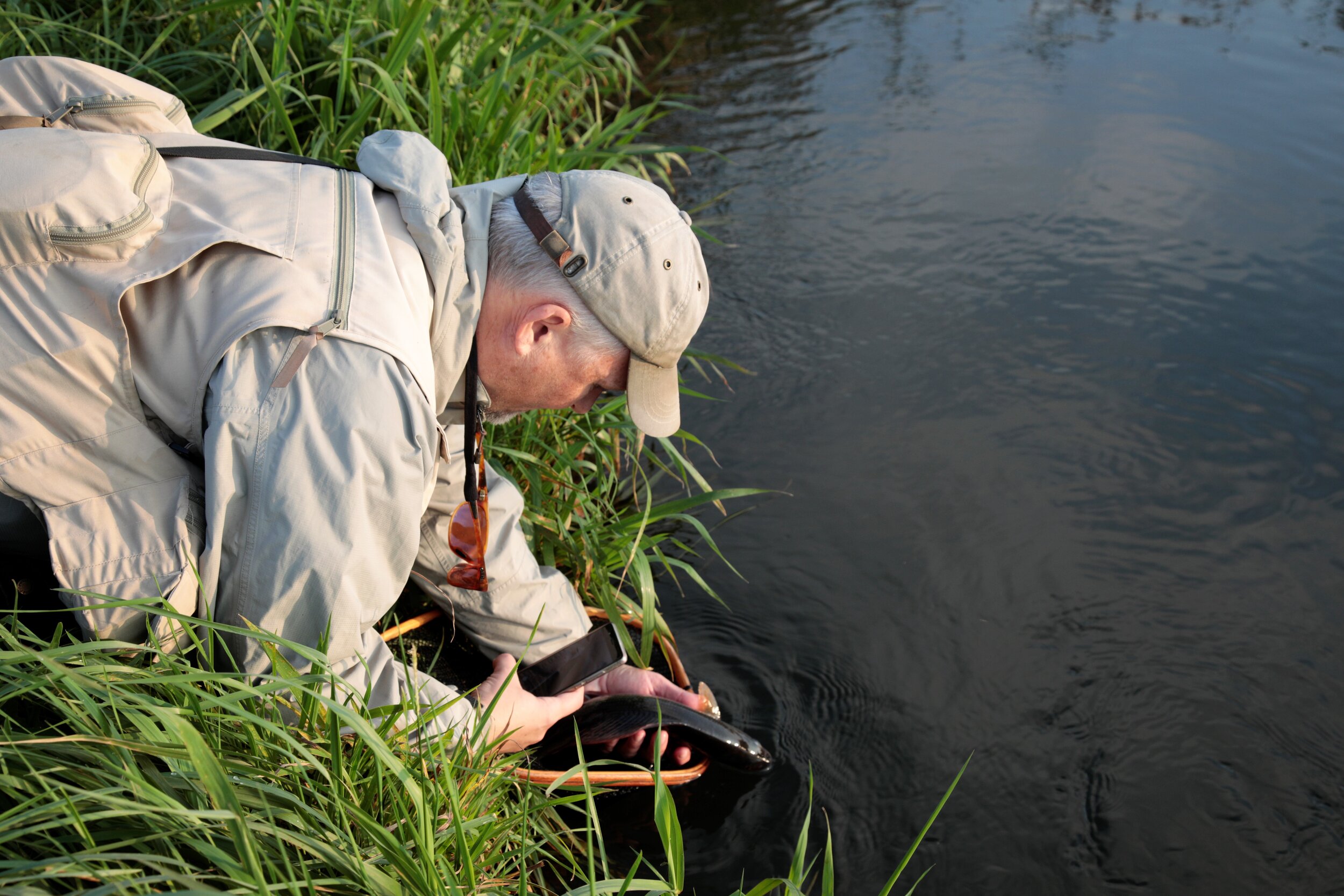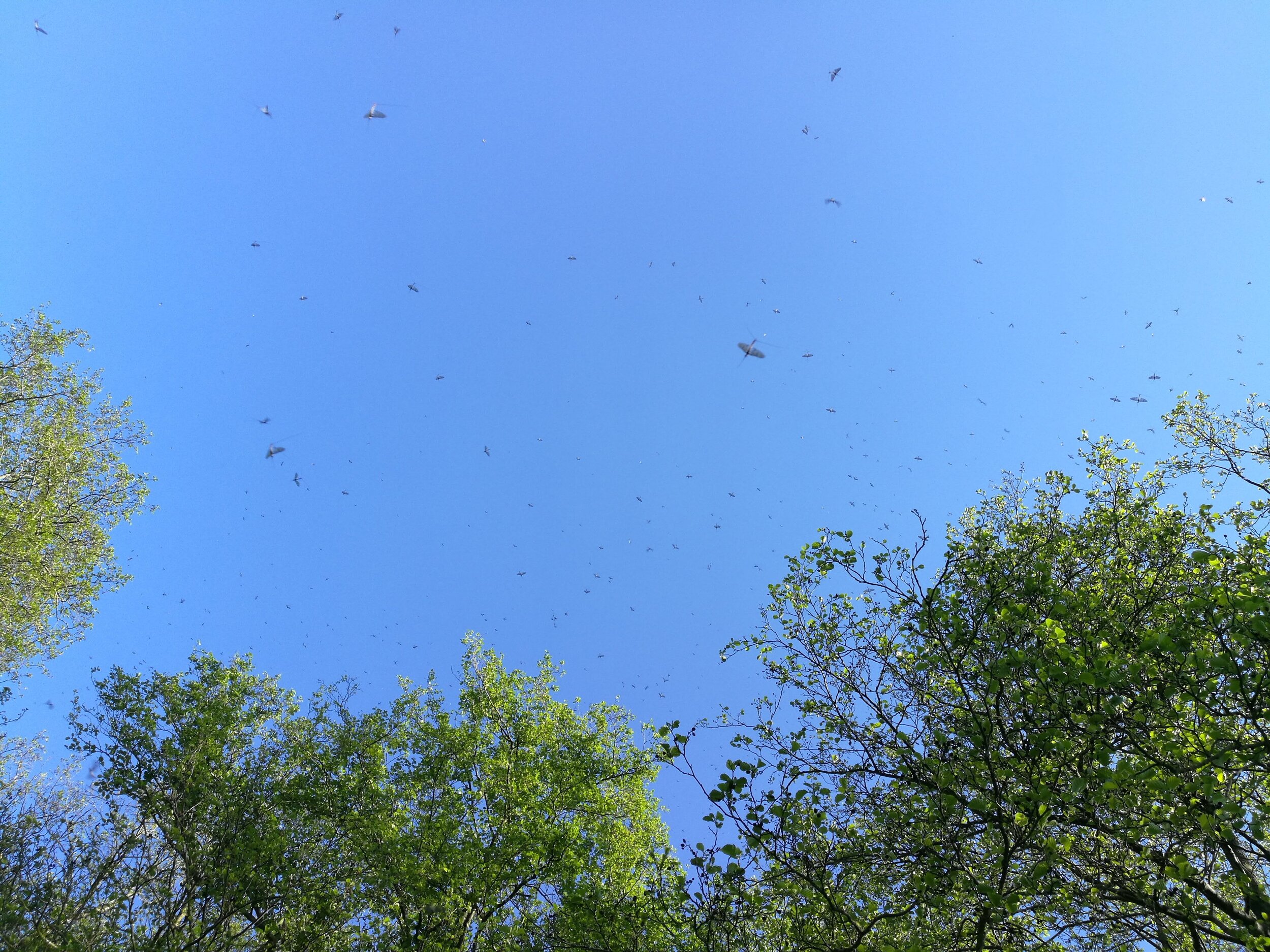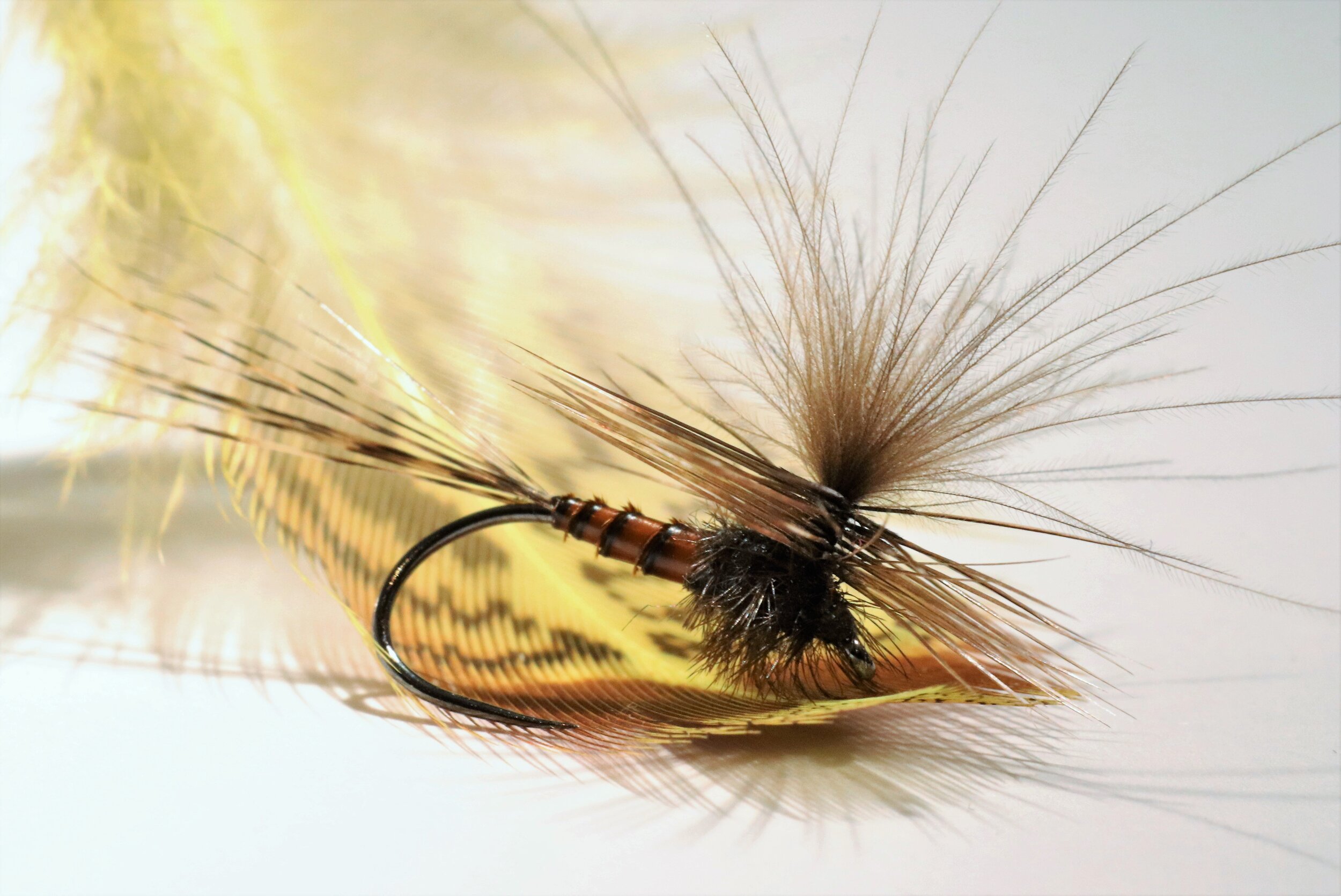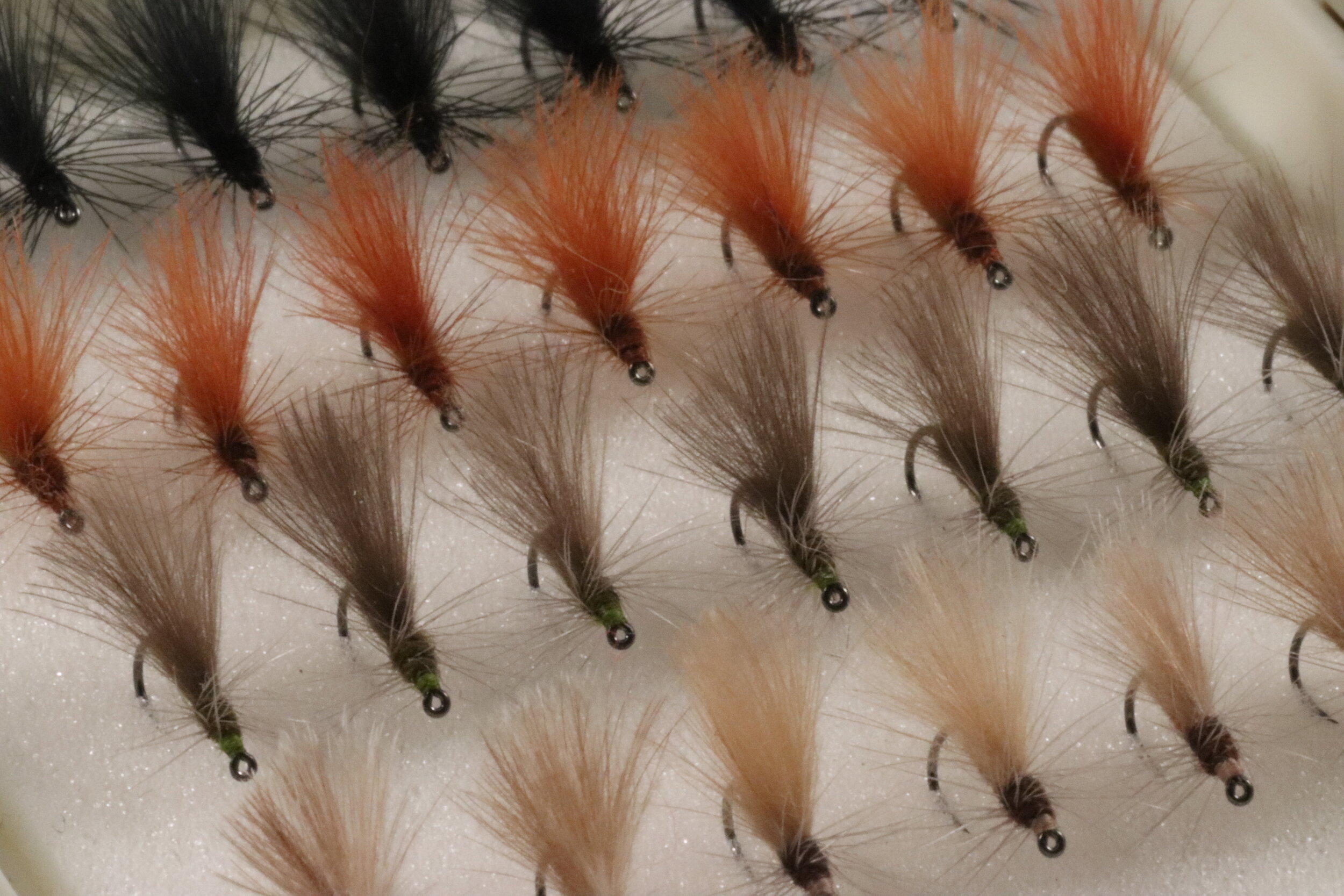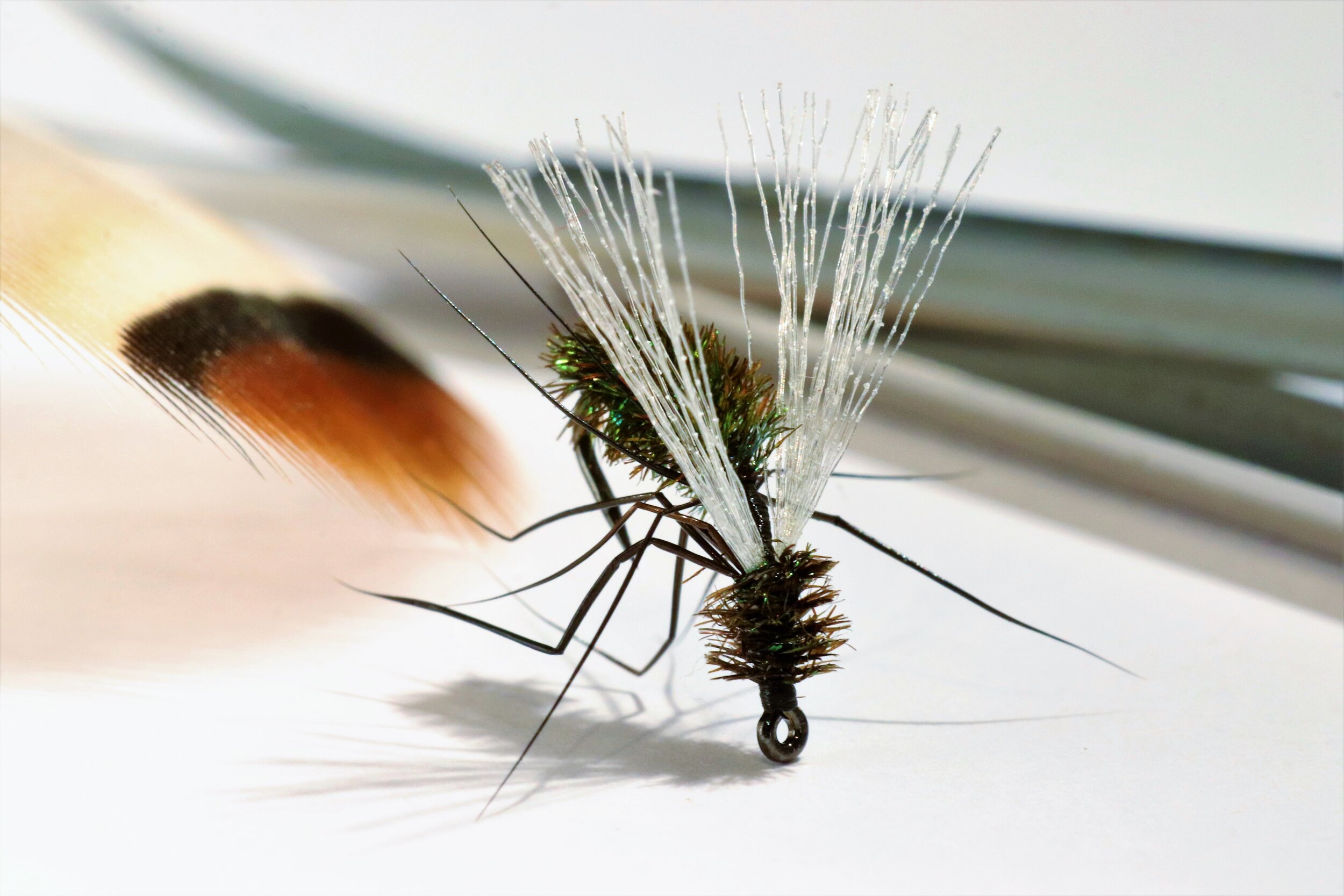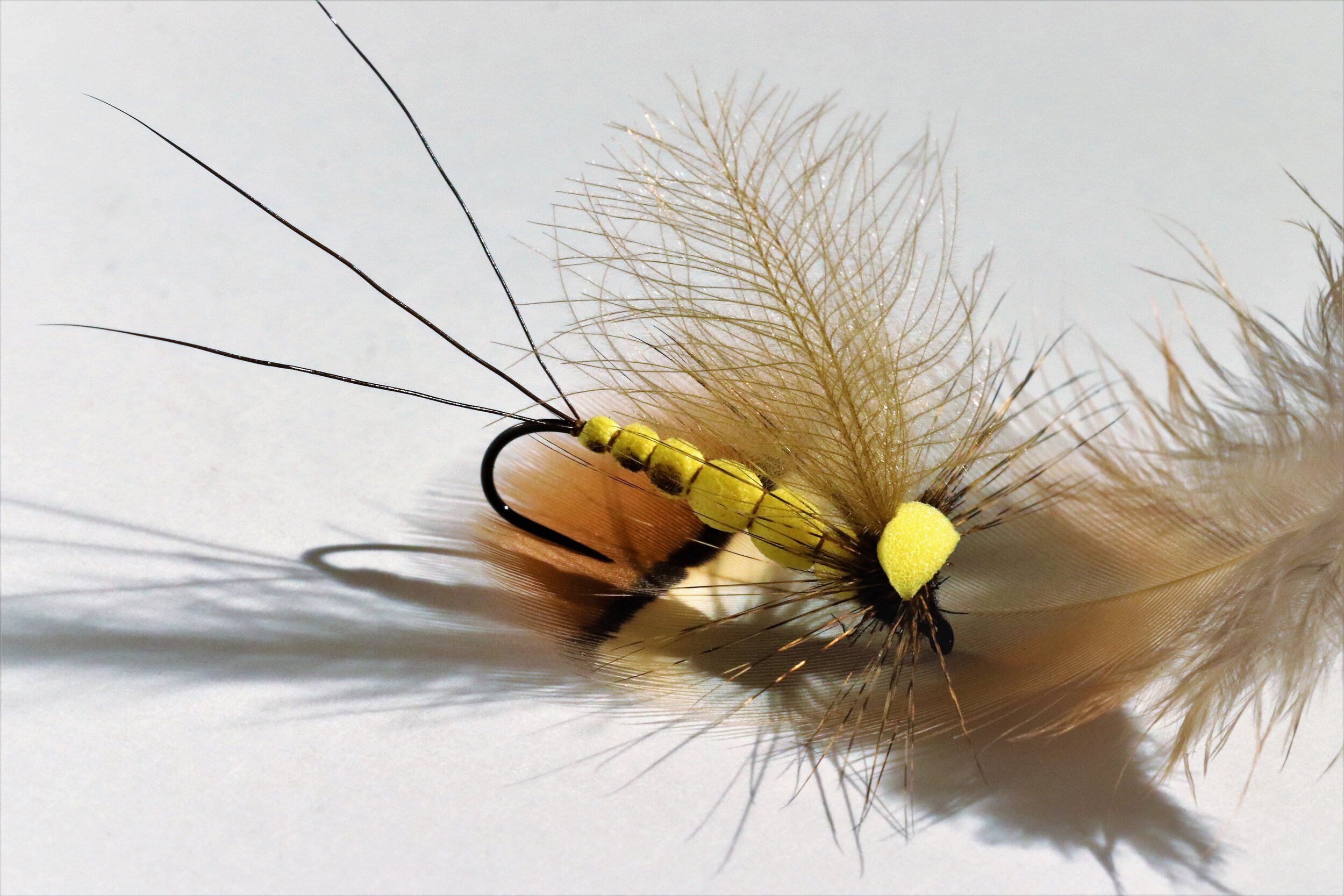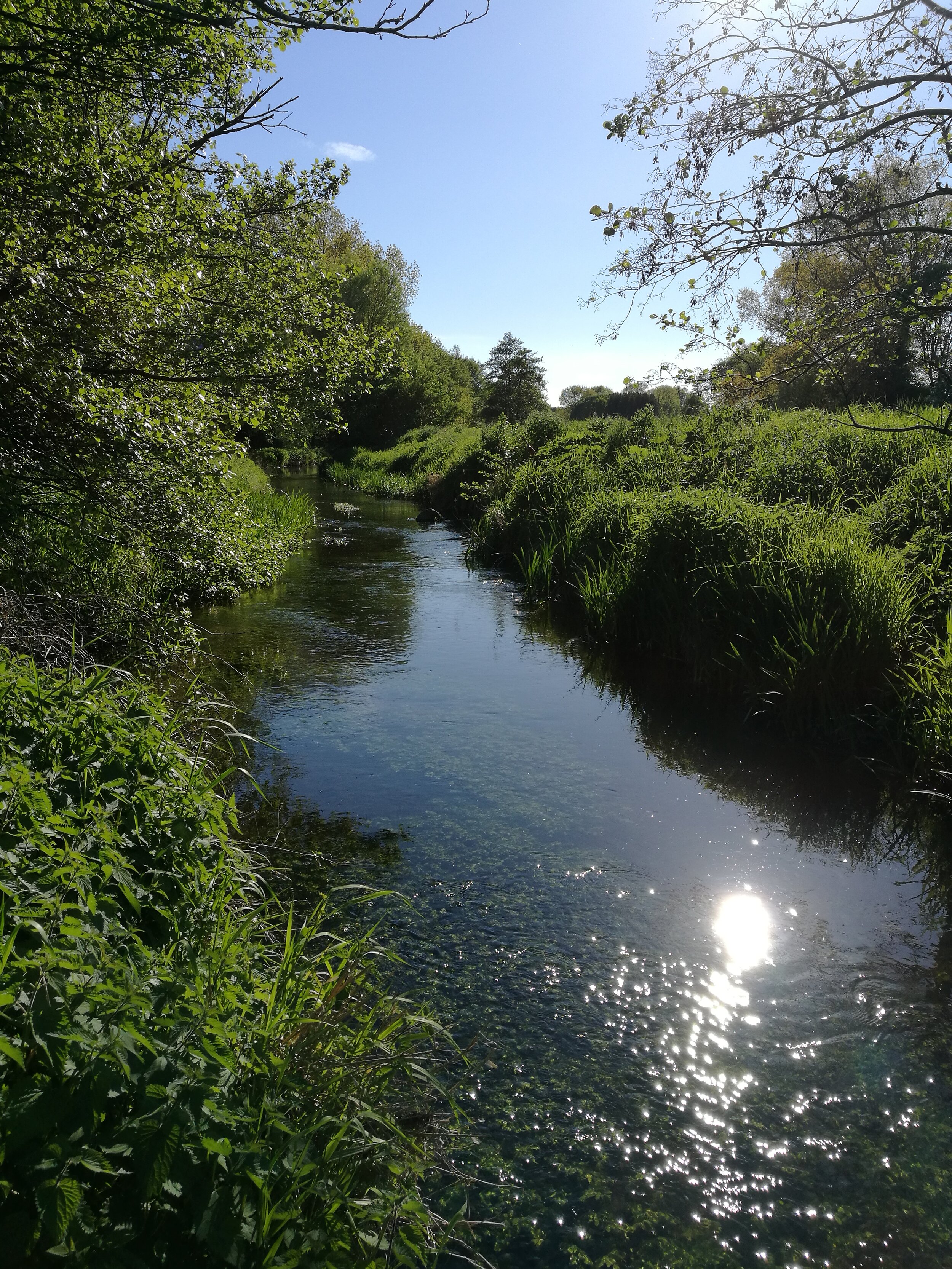
Michael Olesen
Photo: Michael Olesen and Hans v Klinken
1. Choice of equipment, rods, reels, fly lines, fly floatants, clothes, glasses and other useful items.
Oliver Kite once said; ,,Nothing is wrong with the rod, it`s the fool at the end of it” and he didn`t even wear poloraid glasses. Truth be told, I`m no gear-freak either, I`m simply not passionate enough about the subject, which is very clear to me every time I set out to write a new article. I always end up writing about subjects like fly tying, entomology or maybe a little fly-fishing philosophy. I have more than enough fly rods, of which most are bought in my younger years, but in some strange way, I always end up fishing with the same favorite rod. I was, so to speak, brought up with Orvis rods, and the favorite one, that I always bring to my home-waters, I don`t even remember if it`s 8.6 or maybe a full 9 feet long. The fly rod in question, which is a 4 weight, I actually bring on 40-50 trips of the fishing season, so what can I say, other than it really is quite remarkable that I do not think more about the technical specifications than I actually do. But of corse the rod length is of some importance. My favorite rod is definately about 9 feet, to specifically get some height on the line, to be able to perform my back casting over the long grass of the meadows in a relaxed and calm manner. Most streams I fish here in Denmark, are really quite small, and in particular compared to many other dry fly waters around the world. One of my favorite streams is about 10 to 12 feet wide, with many sharp curves where it is required to perform fairly short casting. Therefore, it is extremely important that my 4 weight fly line is of the weight forward kind, to have some weight in the line to work with, even on the very short 10 feet casts. I have cared for and nursed my fly lines for many years. They have been regularly cleaned and polished, not least to preserve them, but also to keep them smooth and fit for fight. But it is no longer necessary for me, as I have purchased a completely new type of fly line. It is the new "Trout" line from Orvis, which requires no treatment, and this is no smooth line like the traditional ones, the "Trout” Line is the exact opposite, namely uneven, to reduce the resistance in the casts. The line is almost silent, which has been a problem before, with previous experiments, with lines of this type. I like lines with very little resistance, but it is definitely something one have to get used to.
When you, like me, are into light dry fly fishing for smaller species, such as brown trout and grayling, the reel is of less importance. I basically only use my reel to store the line, but out of sheer vanity, I have nevertheless spent a good deal of money on this. If my line by some strange coincidence happens to be on my reel, while hooking a good old trout, it never takes a long run. In other words, there is no need for strong brakes on the reel. The trout only take a short run before seeking refuge under banks, weed beds and the like.
I always use floatant on my dry flies, but only a very small quantity . The product I use is an oil called "Dilly wax", which is especially good for poly yarn wing posts and indicators. I add it to the hackle on the fly, but only a very small drop and also a little on the tails, if the fly has a such. I think it works well in general to optimize the floatability of the flies. In some situations and with some lightly dressed flies, it can even be crucial.
I strongly recommend wearing poloraid glasses with bright lenses. They come in many shades and in my opinion one should be careful not to buy them too dark. It's simply easier to spot the fish, with a pair of good poloraid glasses. The dark, as well as the light ones, remove the sun reflection from the water very well, but it is not possible to look as far down into the water column with dark glasses.
When you, like me, is not quite young anymore, it is also noticed to a certain extent in the way I dress. I'm of the generation wearing fish vests, and there is of course no need for changes in that direction. I like a vest with many pockets where it is possible to arrange and sort things. I have arranged myself in such a way that everything I need for a fishing trip is simply on and in the vest. That way, I can quickly and spontaneously get out of the door, without forgetting anything. It's all there: Glasses, reels, pean, line cutter, fishing license, rain jacket, cap, net, flies and much more that I have forgotten about years ago.
All I am wearing is in gray or green natural colors, to attract the least possible attention from the fish.
2. Leader material, build up, lengths and knots.
For dry fly fishing in small Danish streams, it is not necessary with large advanced leader set-ups, on the contrary. I prefer fluorocarbon leaders 9 feet long, tapered from 0.48 mm to 0.15 mm. I always shorten it a bit, make a perfection loop at the thin end, and extend the whole lot with a good 4 feet og tippet material, which is also fluorocarbon. Most of my fishing season I use 0.13 mm tippet material (6x), but in the Danica season I prefer 0.15 mm(5x), which for some probably is head-shaking thin, for those big Danica fellas, but to be able to keep my tippet thin, I have chosen to adjust my Danica flies instead, with a little more weight in the hook, to be able to straighten the leader and tippet out well in the cast. I know quite a few, if not most of my fishing friends, who`s got a much more scientific approach to their leader lengths and set-ups, but for me it is a matter of a feeling. I can not fish like somebody else, or for that matter how my friends do it, I can only fish like myself. In the small streams where I often fish, there are two main issues calling for a compromise, when I am deciding what leader length to fish: 1. It is often a necessity to place the leader right over the fish, which under normal circumstances requires a long tippet. 2. With quite a few trees, shrubs and sharp curves, fishing can often only be done with short casts, which requires a fairly short leader, to achieve a good presentation of the fly. My compromise for this kind of fishing is about 4 feet of tippet material and a total leader length of about 10 feet.
3. Approach and stealth.
My fishing day has already started in the parking lot, long before I`m physically down at the creek. From a distance, a look over the river valley will reveal which river stretches get the most direct sun, where do the riverbanks, shrubs and trees provide the most shade and there is of course also the considerations about wind direction and which stretches have the most shelter for the important insect life.
I am on a full stealth mode when I approach the river, and fully automatically, like pressing a button, my footsteps are getting very soft well over 30 feet before reaching the river bank. If I step on the ground or accidentally step on a branch that breaks, there is a very high possibility that the pressure wave will scare the fish. I have done some suggestive experiments at home in my own backyard where I have koi carps in a garden pond, about 25 feet from my garden door. When I close this door, in a relatively natural way, it simply scares all the fish and make them swim for cover. Now, obviously I do not bring my garden door to the river, but believe me, there is a million other ways to scare the fish. Basically, it helps to know your prey, and trout in particular are always on their fins and constantly scans the surroundings for possible danger. Therefore, a stealthy approach to the stream and the fish is of utmost importance, if not the most important? If your fish have been scared, there are no fish to catch, that’s how simple it is. There are several spots alongside my home-waters, where it is possible to place myself in the shades of shrubs and trees. On the more open stretches, I move excessively slowly and make myself as small as possible. In the first half of the season, when the grass is not yet so high, it is necessary in many places to keep a longer distance to the river. I usually let a trout rise 2 or 3 times before I perform any casting at all, among other things to keep track of whether the selected fish stays where it appeared in the first place. There is nothing more frustrating than making a clumsy and disturbing cast because you have not taken the time to study the fish thoroughly enough. If your targeted fish only rise once, it is in my opinion not active enough and I will only ruin the fishing for myself, with a lot of unnecessary casting. In general I am taking a lot of time just looking, looking and then some looking, with only a little casting when the situation is right. I usually say that I would prefer to hook a fish in the first cast, meaning that if it is actually possible to hook the fish in the very first cast, it is most likely a fish that I have not spooked yet, by rumbling too much around on the banks of the creek. Finally. I would also like to point out that a fish that can be caught from land, SHOULD be caught from land. I would never dream of wading my small streams. It makes too much noise and is completely unnecessary.
4. Reading the water
To read the river is both to interpret the surface of the water, to know something about the underwater landscape, but to a large extent also the landscape around the river. I do not feel completely sure that I can contribute with anything new to this topic, but then again, learning can also sometimes "just" be to re-fresh your mind. Some knowledge from my younger days is still with me, somewhere in the back of my head and one of the doctrines that has followed me is:,, Where the current flow is breaking, the fish are also taking a break” In other words, it is the irregularities that needs to be looked for, and some of the most obvious are of coarse: Back eddies, narrows, rock formations, bridge piers, large stones, vegetation alongside the stream, undercut banks, deep holes and more. Most fly fishermen know this basic stuff, but the most interesting thing I actually think is the lies and situations that do not immediately make sense, a fish surprising you in a spot with no shelter or rest for that matter. Even though all our brain cells are finetuned and working out the logics, and seemingly we have read the water 100%, the river is a living variable size, where so much is going on that affects the fish's habitats, it could be the fish's migrations, water levels, insect hatches and something as simple as the sun's power and location in the sky. Yes, there really is a lot of information to put in the equation and it all complicates the calculation, which brings me back to recommending stealth mode and taking your time having a good look on the river before casting. All together it helps me a lot with my local experiences, which leads me to fish the best spots at the right time. I spend a lot of time studying the creek, with only a minimum of casting. On the rather straight river parts, it is not that difficult to figure out which way the fish are turning, but I am always extra careful when approaching the more curvy parts with back eddies, where my calculations are not always that easy. Some curvy stretches can be real tricky, as it can be holding several fish, quite close even, and they are turning in all directions. I especially have two curves of that kind, in my mind, where fishing in the daytime causes great difficulties, as I am always too exposed to at least one of the targeted fish, which scares the rest of his “friends”. The fish are wild and therefor quite wary, and for that reason a lot easier to get close to, in the late evening hours, where I am not nearly as visible.
A winter's floods can also change a stream quite a lot, and it's always exciting to start a new fishing season, where my waters quite often surprise me with a new lie or two.
5. Casting ability which casts are essential.
Many years ago, I was very much into learning a lot of different types of casting, with the naive notion that I probably needed it all. Much older now, and hopefully a little wiser, I have learned that I just need a few of them. But having said that, I would recommend anyone to attend casting courses, to learn the basics or just finetuning your techniques. If possible, I would very much like to be close to my prey when I perform my casting. It increases my advantages, in terms of precision, striking, good hooking of the fish and the following fight. In fact, there is never a need for long casting, in the small streams where I fish. I mostly use a short overhand cast, to get the line over the shrubbery and the tall grass. But where the conditions do not allow a so-called ordinary overhand cast, I recommend learning to cast over your opposite shoulder, that way it is possible to keep the line over the creek in the false casting. It is also quite common with challenges such as shrubs and trees, where I change the angle of my fly rod and use casting with sudden stops if necessary, to get the fly presented well. A final cast, which sometimes can be an advantage to have in your program, for the slightly longer downstream presentation, is the snake cast, which ensures a longer drag-free drift for your fly. But overall, the most important thing is a sensible overhand cast, that can be delivered silky soft on the water.
6. Entomology, what should we know.
Understanding Insects has grown to become a rather big hobby of mine over the years, but what is really necessary to know about insects, to enjoy a nice dry fly day on the river, actually is quite limited. As I see it, there is nice-to-know and need-to-know. Personally, I like to have a fairly good overview of the insect hatches of the season, just to make it possible for me to bring some suitable flies when fishing. The knowledge of insects can also contribute, in a quite practically way, for planning a fishing trip. What I mean it, that there is not much fun in being all set for fishing 4 o`clock in the morning, if there are no hatches before 2 o`clock in the afternoon. Sunshine hours, air-pressure and weather changes also affect insect life, which naturally affects the fish's eating patterns. There is certainly a lot of good and useful knowledge if you stick your nose in the books and soak yourself in the subject. There is also a another sensible and slightly faster way, to imitate the insect life in and around the water, which can be achieved by training your observation ability. If you start from scratch, one of the first things to learn is to know the difference between the flying insects, roughly stoneflies, sedges and mayflies etc. and in addition find out what size they are. There are usually some specimens to look at and get close to, in the grass and in spiderwebs, and in this connection it may be useful to know that practically all insects look somewhat larger in the air than they do when sitting in the grass. Alternatively, try noticing how your fly look on the water, compared to the real insects that come floating next to it. You might also say that it doesn`t matter how much your flies look like the natural ones, as long as the fish take what you are presenting, but if you have challenges in making the fishing work, it can certainly be useful to match the insects that hatch or fall on and in the creek. It is not necessary to know the names of the insects, but overall I think it makes sense to have basic knowledge about the behavior of the insects, as this is reflected in the behavior of the fish and their rise forms that reveal what it is they are eating.
7. Rise forms: Can they tell us something.
It is quite important to be aware that the fish consume their food at different depths, with associated different movements, at different speed. It all makes sense if you take the time to study and think a little about the fish's way of taking the insects in different stages. A trout rarely speeds up if it is not necessary, so when it comes hammering from the depths, with an accompanying splash or swirl in the surface, it is very probability because the food item it is chasing, also comes at a full speed from the bottom of the river. Typically this would be hatching sedges, but it could also be other insects in a slightly slower motion, where the trout have gained the experience that the hatching insects are quick at taking off from the water surface. Some insects, such as the Yellow May, Heptagenia Sulphurea, have already left their nymph skin at the bottom of the river, and thus have a rapid process through the water surface, and therefore get started faster with the hardening of the wings, and dries up in a hurry. When the fish turn and roll in the surface, as just described, it is an indicator for me to fish my emergers or low-sitting dries. You can also be fooled by situations where the fish seem to take dry, but on closer inspection they do not break the water surface. Such a situation may require a highly fished nymph or perhaps a mayfly which is stuck on the underside of the water surface. One of the more certain signs that tells a trout has taken a fly on the surface itself, a regular dry fly, is that it often leaves visible air bubbles in the middle of the ring. This is of course somewhat easier to notice at a short distance, in one of the small Danish rivers, compared to let`s say Glomma in Norway, which is much larger.
After a long day of fishing, where I have been through nymph, emergers and dun fishing, the last significant event of the evening is the so-called spinner fall. At this time of day, you will see that the fish take the flies much more carefully, which is also quite obvious, as the insects lie on the water to die, and such a food item which does not escape from the water again, the trout do not have to hurry to inhale. A lot can definitely be said about different "rise forms" from dimples to head and tails and much more, but after all, I think the most important thing is to spend some time learning basic theory, combined with using your senses. My experience tells me that you can`t read everything, but that it is absolutely crucial to get out to the river and fish. Specifically, I have two examples of local fishing situations that I have not been able to use the books for. One situation is the wandering trout which are unusually in an upstream motion in the evening when picking up spinners, and the other situation, or perhaps just a phenomenon, is that the trout are not nearly as steady in their lie as many people think, which may lead one to believe that there are two fish next to each other when there is actually just one. I often experience this during my sedge fishing when they both hatch and run across the creek at the same time. This situation produces several different types of "rise forms" at the same time and fish are moving in all directions. It can be both easy fishing, but it can most certainly also be difficult, and that is truly what I find fascinating about flyfishing.
8. Fly selection, size, shape, materials, which flies are essential.
As a dedicated fly tyer, I simply have to say that the flies are important, but in fact the truth is that they are not nearly as important as presentation and stealth. If I have to strike a blow for fly tying and the importance of flies, in only a few lines, then I would initially recommend tying your own flies. First of all, it's pure therapy to sit by the vice and prepare for the season while dreaming your way out to the fishing water. There are also many fly-tying ideas that arise by the river, where the practical reality overtakes all theories, and then it is quick and easy to get some new flies tied, exactly as they were meant to be. Such flies do not exist commercially.
The most important flies are not the ones I think that I will be needing, during a winter`s tying, but the ones I have actually used. As a matter of fact, I think it could be a fun experiment, to take a picture of my fly patch after each fishing trip all year round, to get an idea of which ones are my real fishing flies. Most likely I will be quite surprised myself, and maybe I will even think that I have chosen some rather boring flies. The idea is hereby passed on.
I will always try to match the actual insects in and around the creek, with my home-made creations, and that is precisely why I rarely find out if there is anything else that works just as well. At the same time, imitation is much more than just sizes and proportions. The fly's so-called key stimuli can also be turned up and down, which could be things like more or fewer legs and / or larger or smaller wings and so on. and before I get into anything reminiscent of a religion, I will return to the simple flies that work and have worked for ages. Strictly speaking, I could fish with a Fratnik-like fly in sizes 16 and 14 half of my fishing season and turn up the fly size during Yellow May and Danica hatches. It probably would not be 100% effective, but I'm pretty sure it would pay off quite well. But since I do not find it particularly satisfying to give up on the more challenging fish, due to my fly being rejected, there must of course be some flies to choose from in the fly box. A fish caught, after one or more fly changes, is a fun fish to catch. It feels like a deserved fish. I do fly changes quite often, sometimes to get a little wiser on my fly-tying theories, but it can also just be a practical shift, to something that the fish can actually see, either a fly that sits deeper in the water film, which is immediately seen better from all angles, or a darker fly with a harsher contrast, for the late evening fishing.
One last practical fly remark: I always use as soft materials as possible in my flies, and this is especially true for the wings. Too stiff wing material that does not fold properly when casting results in twisted leaders, and I have learned this the hard way and know that it can turn into a true nightmare.
9. Presentation and drifts.
This subject is in a natural way linked to "rise forms", "entomology" and imitation in general. However, some kinds of presentation also have to do with casting technique, but it is rarely the case. This is my personal philosophy and approach to the subject, but of course it is also a fundamental necessity to be in possession of rather good casting abilities. It is about presenting the fish's food imitations as realistically as possible. A sedge fly with a house comes tumbling on the bottom of the river, hatching nymphs are on their way to the surface, other insects are on their way to the bottom of the river, to lay their eggs, some sedge flies run across the river when they are hatched and so on. These are all levels, stages and movements that are my first and foremost challenge to imitate. But instead of going through all possible and impossible kinds of presentation, I would encourage you to more than a theorist, and spend as much time as possible with a fishing rod in your hand, in order to become a little more pragmatic and get experience and common sense connected to all the theories. I'm basically very stealthy with my dry fly presentation. The fly must land silky soft, so as not to scare the fish. As mentioned earlier, I fish in some quite small streams, where it is usually necessary to place the tippet directly over the fish, which is just another obstacle that requires caution. Usually, I prefer to deliver my fly 5 feet in front of the targeted fish. But quite often it is effective to deliver the fly in the "box" which is the common fly-term for almost on the tip of the nose of the fish, so that it can barely respond to the fly that lands. I think this technique is quite natural to use during a spinner fall and under trees, where the fish are used to the food coming descending from above. Of course, it is also a necessity that the fish can see my fly. When I sometimes experience a fish not responding to my fly, the solution quite often turns out to be as simple as changing the location of my fly, to the opposite side of the selected fish. There is not always a clear answer as to why this is so, but sometimes I have subsequently been able to see that the angle of the view of the fish has changed to make the fish able to see the fly with the sky as a background instead of the somewhat darker river bank.
10. Upstream or downstream?
To me, it makes sense to mainly fish upstream, but it is of course the fishing situation that is crucial. I have previously mentioned my "little-stream-dilemma" where I have to put my tippet right over the head of the fish, in at least 80% of my casts. I therefore fish with as thin a tippet as possible and of course I have to be extremely careful. Should I, on the other hand, choose downstream presentation, there are also various disadvantages to deal with. In this position I am more exposed to the fish, which has most of its attention directed upstream, and it is therefore also necessary to keep a longer distance to my prey, to make myself as small as possibly and perform my blind casting low above the river surface or over the surrounding fields, depending on the situation, and while I`m at it I must add that a 9 foot shiny waving fly rod is a particularly frightening sight for a wary trout.
The slightly longer downstream casts can have the unfortunate side effect that there are slightly more fault hookings or lost fish, especially on the very small hooks. In this situation, it is usually best with a moderate lift, to hook the fish more securely. However, if possible, I prefer an upstream cast where I can get so close to the fish and follow its movement when it takes the fly. It is nerve-wracking and delightful, at the same time, but first and foremost it is safer fishing.
11. Fighting fish.
Fighting a fish is a "dance" with limitations and benefits, both for fish and fisherman. I have a small advantage, by being as close to the fish as possible, as the trout is having the bad habit of going in the weeds or slipping under a nearby bank. The fish benefits greatly from the many undercut banks where I fish, and therefore I have more control over the fight if my rod tip can be angled advantageously and in some cases I even have the rod tip under water. When the fish goes into the weeds, it must be helped out, the same way it came in. It is all about being attentive and follow the fish.
It is incredibly important to know your gear and have it well tuned. Last season I just got a reminder about this, during the Rhodani fishing when I got into a nice 20 incher, on what I thought was a hook size 14. I was fishing with 0.15 tippet and thought it was just fine to fight the fish reasonably hard. When I got the mentioned fish to my net I got myself a bit of a surprise, as the hook was straightened halfway out. At closer inspection, the hook turned out to be a light wire size 16, which had been working a little overtime.
I am a big supporter of fighting the fish briefly and as sensibly as possible, not to overload them. But, because there is a but, one can unfortunately also get too eager and push both gear and fish so hard that it all ends up in a messy and chaotic show, with a lost fish as a result. You always have to use your common sense and experience to adapt to the situation.
I land my fish head first, in a knotless catch and release net. I always have wet hands if I have to touch the fish, to not ruin its protective slime layer and if I have to take a picture of my catch, I will then leave it a little in the net first, to make it partially gain it`s strength back. I have the greatest respect for the poor fish who has fought for its life, because that`s literally what it does, and therefor it's my responsability not to expose it to unnecessary danger. By comparison, I probably would not survive having run a marathon, and right after completely exhausted and short of breath, having to stick my head in a tub of water.
It is about common sense, to fish gently and to be in harmony with the nature.
Tight lines
Michael Olesen

